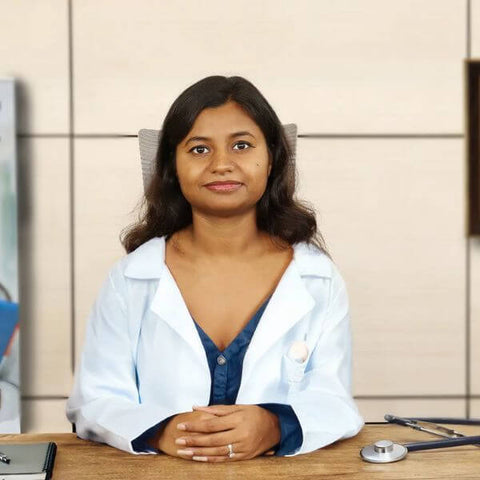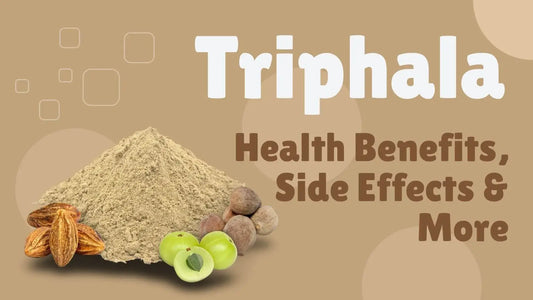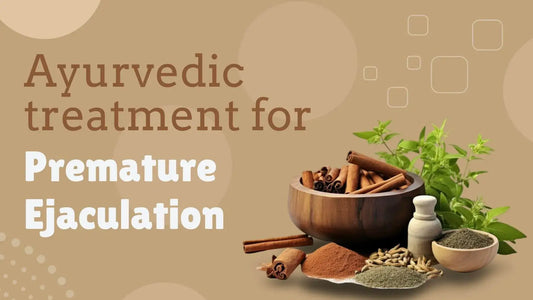
Types of Hemorrhoids - Understanding the Different Stages and Types
Hemorrhoids are commonly known as Piles. It happens when the swollen veins enlarged form inside and outside anus and rectum.
A 1990 study by Johanson et al. found hemorrhoids affected 10 million Americans, mostly between the ages of 45–65, with rare cases before age 20.
Hemorrhoids can be either internal, located inside the rectum, or external, located under the skin around the anus.
While everyone has hemorrhoids, they typically don't cause problems unless they swell and become irritated.
There are 4 types of Hemorrhoids
-
Internal
-
External
-
Thrombosed
-
Prolapsed
In this blog, we have explained the different types of hemorrhoids. Keep reading to know more:
1. Internal Hemorrhoids

Internal hemorrhoids develop inside the rectum and are usually not visible or felt. These hemorrhoids often cause bleeding during bowel movements, but they might not cause immediate pain.
Location: Inside the rectum
Symptoms:
-
Painless bleeding during bowel movements
-
Mucus discharge
-
Swelling or bulging inside the rectum (in severe cases)
Treatment: Typically, internal hemorrhoids can be managed with over-the-counter remedies, lifestyle changes, or medical procedures in severe cases.
2. External Hemorrhoids

External hemorrhoids occur around the anus and can be seen or felt. They are more likely to cause pain, itching, and irritation.
Location: Around the anal opening
Symptoms:
-
Painful swelling or lumps near the anus
-
Itching or irritation
-
Bleeding when wiping
Treatment: External hemorrhoids are often treated with topical creams, sitz baths, and pain relievers. In some cases, surgery may be necessary for persistent or large hemorrhoids.
3. Thrombosed Hemorrhoids

Thrombosed hemorrhoids are a more severe form of external hemorrhoids. They occur when blood clots form within the swollen vein, causing intense pain and swelling.
Location: Usually external, around the anus
Symptoms:
-
Severe pain, especially when sitting or during bowel movements
-
A hard, tender lump near the anus
-
Possible bleeding or discharge
Treatment: Thrombosed hemorrhoids may require medical procedures to remove the clot, such as drainage or surgical excision.
4. Prolapsed Hemorrhoids

A prolapsed hemorrhoid is an internal hemorrhoid that has become so swollen that it protrudes from the anus. It may go back inside the body on its own or require manual adjustment.
Location: Initially inside the rectum, but protrudes through the anus
Symptoms:
-
Protrusion of hemorrhoids outside the anus
-
Bleeding, especially after bowel movements
-
Feeling of fullness or discomfort in the rectum
Treatment: Mild cases may resolve on their own, but severe prolapsed hemorrhoids may need medical procedures like rubber band ligation or surgical removal.
How to diagnose different types of hemorrhoids?
Hemorrhoids are commonly diagnosed through a combination of medical history review, physical examination, and sometimes specialized tests.
Here's how hemorrhoids are typically diagnosed:
1. External Hemorrhoids
Preferred Diagnosis: Visual Inspection + Physical Examination
Why?
External hemorrhoids are located under the skin around the anus and are usually visible to the naked eye. The doctor can confirm the diagnosis through a simple visual exam and gentle palpation (feeling for swollen veins).
When additional testing is needed: Rarely required unless other conditions are suspected (e.g., abscess or skin tag confusion).
2. Internal Hemorrhoids
Preferred Diagnosis: Anoscopy + Digital Rectal Examination (DRE)
Why?
Internal hemorrhoids lie inside the rectum and cannot be seen externally. A Digital Rectal Exam (DRE) helps detect any swelling or masses, while an anoscopy provides a direct view inside the anal canal to confirm internal hemorrhoids.
When additional testing is needed: If symptoms include persistent bleeding, change in bowel habits, or if the patient is over 50, a sigmoidoscopy or colonoscopy may be used to rule out serious conditions like colorectal cancer.
3. Thrombosed Hemorrhoids
Preferred Diagnosis: Visual Inspection + Manual Palpation
Why?
A thrombosed hemorrhoid is an external hemorrhoid that has developed a blood clot. It appears as a painful, bluish lump near the anus. Diagnosis is usually straightforward with direct visual and tactile examination.
When additional testing is needed: In cases with severe pain or signs of infection, a rectal ultrasound or imaging (CT scan) might be performed to rule out abscess or other complications.
4. Prolapsed Hemorrhoids
Preferred Diagnosis: Visual Inspection + Anoscopy (if needed)
Why?
Prolapsed hemorrhoids are internal hemorrhoids that protrude through the anus. Mild cases may resolve on their own; severe cases remain outside. These are often visible during straining, and in some cases, anoscopy is used to inspect the extent of prolapse inside the rectum.
When additional testing is needed: If bleeding or prolapse is excessive or doesn’t improve with treatment, sigmoidoscopy or colonoscopy may be performed.
Treatment of Hemorrhoids
Hemorrhoid treatment depends on the severity of the condition. For most people, hemorrhoids can be managed effectively with lifestyle changes and over-the-counter remedies. In more severe cases, medical treatments or surgical procedures may be required. Here’s a breakdown of the different treatment options for hemorrhoids:
1. Home Remedies and Lifestyle Changes
For mild cases of hemorrhoids, simple home remedies and lifestyle changes and home treatments can provide relief.
-
Dietary Changes: Increase fiber intake by consuming fruits, vegetables, whole grains, and drinking plenty of water. This helps soften stools, reducing strain during bowel movements.
-
Warm Sitz Baths: Soaking the anal area in warm water for 10-15 minutes can help relieve pain, itching, and inflammation.
-
Over-the-Counter Creams or Ointments: Topical creams like hydrocortisone or witch hazel can reduce inflammation, itching, and discomfort.
-
Cold Compress: Applying ice packs or cold compresses to the affected area can help reduce swelling and numb pain.
-
Avoid Straining: Straining during bowel movements puts pressure on hemorrhoids, so try to avoid it. Use a footstool to elevate your feet and assume a more natural position during bowel movements.
- Ayurvedic Herbs: Some Ayurvedic herbs, such as Triphala, Turmeric, and Guggul, are known for their effectiveness in managing piles. Using these herbs may help relieve symptoms and support recovery.
2. Medications
If lifestyle changes aren’t enough, medications can help control symptoms.
-
Pain Relievers: Over-the-counter pain relievers, such as ibuprofen or acetaminophen, can help alleviate pain and inflammation.
-
Topical Steroids: Hydrocortisone creams can help reduce inflammation and itching in mild cases.
-
Oral Stool Softeners: These medications help soften stools and make bowel movements easier, preventing further irritation of hemorrhoids.
3. Non-Surgical Medical Treatments
If home remedies and medications don't provide relief, several medical procedures can be done to treat hemorrhoids.
-
Rubber Band Ligation: This is one of the most common treatments for internal hemorrhoids. A rubber band is placed around the base of the hemorrhoid to cut off its blood supply, causing it to shrink and fall off.
-
Sclerotherapy: A chemical solution is injected into the hemorrhoid, causing it to shrink and eventually be reabsorbed by the body.
-
Infrared Coagulation: A special infrared light is used to coagulate the blood vessels, causing the hemorrhoid to shrink.
-
Laser Therapy: Laser treatment is used to burn and remove hemorrhoidal tissue, providing relief from bleeding and swelling.
4. Surgical Treatment
In severe cases, surgery may be needed. Surgical options are typically considered for large hemorrhoids that do not respond to other treatments or when there are frequent recurrences.
-
Hemorrhoidectomy: This is a surgical procedure to remove large or prolapsed hemorrhoids. It is usually done under general anesthesia and is effective for severe hemorrhoid cases.
-
Stapled Hemorrhoidopexy: This surgery involves stapling the hemorrhoids back inside the rectum. It is less painful and has a quicker recovery time than hemorrhoidectomy, though it may not be suitable for all patients.
5. Preventing Recurrence
Once hemorrhoids have been treated, it’s important to take steps to prevent them from returning.
-
Maintain a High-Fiber Diet: Continue eating a fiber-rich diet to avoid constipation and straining.
-
Exercise Regularly: Regular physical activity helps keep the digestive system functioning smoothly and prevents constipation.
-
Stay Hydrated: Drinking enough water daily helps keep stools soft and easy to pass.
-
Avoid Prolonged Sitting: Sitting for long periods, especially on the toilet, can increase pressure on the veins around the anus.
When to see the doctor?
It would be necessary to get in touch with the doctor or ayurvedic physician to explain your condition of piles.
1). You should not delay with the treatment when the symptoms are:
-
Extremely painful to bear anymore.
-
Itching and irritating highly.
-
The color of the skin near the anal area turns blue.
-
Swelling of the tissues not shrinking or prolapsed hemorrhoids not reducing.
2). It is when after offering the right diet for piles. Fiber-rich diet softens the stool and controls inflammation and bleeding. But many may experience healing even after it. It is then a doctor’s intervention is necessary.
3). If anyone is not finding successful recovery with home remedies for hemorrhoids. Normally, piles patients go for a sitz bath, apply and use coconut oil in the wound area of the anus and use it for cooking and drinking herbal tea. Even if after using such remedies, Even after using such remedies, if one does not experience a comfortable recovery then one should contact the doctor immediately.
Summary
The problem of different types of hemorrhoids is happening with millions in India. The causes of piles may vary from one patient to another. But one must be careful of selecting the diet.
Otherwise, you will be likely to see trouble very shortly arising in the anal area in the form of inflammation, swelling of veins and bleeding. You will not have smooth bowel movements.
To identify the exact condition and cause of external, internal, and thrombosed piles, you can get in touch with a certified medical practitioner. You can also try Ayurvedic medicine as an alternative measure.
FAQs
Q1. What are the 4 stages of hemorrhoids?
Ans: The 4 stages include internal, external, thrombosed, and prolapsed hemorrhoids. Each has a different location, symptoms, and severity.
Q2. What is the most common type of hemorrhoids?
Ans: Internal hemorrhoids are most commonly found and cause painless bleeding during bowel movements.
Q3. Can Stage 4 piles be cured?
Ans: Yes, but they usually require surgical procedures like hemorrhoidectomy or stapled hemorrhoidopexy.
Q4. What is the main cause of hemorrhoids?
Ans: The main causes include straining during bowel movements, constipation, and sitting for too long periods.
Q5. Are Stage 3 hemorrhoids curable?
Ans: Yes, stage 3 hemorrhoids can be treated with rubber band ligation or surgery if needed.
Q6. Are hemorrhoids 100% curable?
Ans: No, with early treatment and lifestyle changes, hemorrhoids can be managed.
References
- Fontem RF, Eyvazzadeh D. Internal Hemorrhoid. [Updated 2023 Jul 31]. In: StatPearls [Internet]. Treasure Island (FL): StatPearls Publishing; 2025 Jan–. https://www.ncbi.nlm.nih.gov/books/NBK537182/
- Lawrence A, McLaren ER. External Hemorrhoid. [Updated 2023 Aug 8]. In: StatPearls [Internet]. Treasure Island (FL): StatPearls Publishing; 2025 Jan–. https://www.ncbi.nlm.nih.gov/books/NBK500009/
- Wang ZG, Zhang Y, Zeng XD, et al. Clinical observations on the treatment of prolapsing hemorrhoids with tissue selecting therapy. World J Gastroenterol. 2015;21(8):2490–2496. https://www.ncbi.nlm.nih.gov/pmc/articles/PMC4342928/
- Picciariello A, Rinaldi M, Grossi U, et al. Management and treatment of external hemorrhoidal thrombosis. Front Surg. 2022;9:898850. https://www.ncbi.nlm.nih.gov/pmc/articles/PMC9110961/
- Ganchrow MI, Bowman HE, Clark JF. Thrombosed hemorrhoids: A clinicopathologic study. Dis Colon Rectum. 1971;14(5):331–340. https://journals.lww.com/dcrjournal/abstract/1971/14050/thrombosed_hemorrhoids__a_clinicopathologic_study.1.aspx
- Chen YY, Cheng YF, Wang QP, et al. Modified procedure for prolapse and hemorrhoids: Lower recurrence, higher satisfaction. World J Clin Cases. 2021;9(1):36–46. https://www.ncbi.nlm.nih.gov/pmc/articles/PMC7809675/
- Lu M, Yang B, Liu Y, et al. Procedure for prolapse and hemorrhoids vs traditional surgery for outlet obstructive constipation. World J Gastroenterol. 2015;21(26):8178–8183. https://www.ncbi.nlm.nih.gov/pmc/articles/PMC4499363/

Dr. Pooja Verma
Dr. Pooja Verma is a sincere General Ayurvedic Physician who holds a BAMS degree with an interest in healing people holistically. She makes tailor-made treatment plans for a patient based on the blend of Ayurveda and modern science. She specializes in the treatment of diabetes, joint pains, arthritis, piles, and age-related mobility issues.




